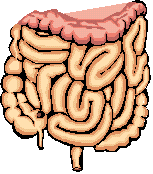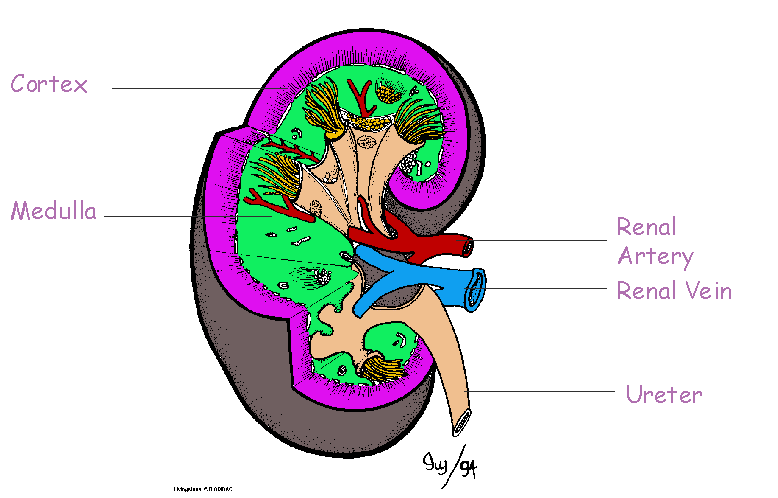
Digestion
Mechanical digestion: physical breakdown of food molecules to allow surface area for enzymes to work.
Chemical digestion: breakdown of macromolecules into building blocks done by enzymes.
Extracellular digestion: enzymes are secreted outside the cell to break down macromolecules.
Intracellular digestion: food molecules are brought into the cell for break down.
Nutrition
Macronutrients: molecules needed in large amounts by the body.
CarbohydratesLipids
Proteins
Micronutrients: molecules needed in small amounts by the body
Vitamins: organic molecules used as coenzymes.Fat soluble vitamins: A, D, E, KWater soluble vitamins: B, C
Minerals: inorganic molecules used as cofactors.
Amino acids
Excretion
Nitrogenous waste results from the breakdown of proteins.
Ammonia: toxic water-soluble nitrogenous waste.Urea: non-toxic water-soluble nitrogenous waste.
Uric acid: non-toxic insoluble nitrogenous waste.
Porifera
filter feeders. Collar cells digest nutrients and send to amoebocytes.Water current removes waste.
Cnidaria
cells lining gastrovascular cavity secrete strong digestive enzymes.Waste in cavity leaves through same opening.
Platyhelminthes
Food sucked into pharynx on underside of body; nutrients absorbed through intestinal wallUndigested waste passes through pharynx. Flame cells eliminate liquid waste.
Nematoda
Anterior mouth; digestive tubeAnus; liquid waste through excretory pore.
Gastropoda
radula scrapes food; complete digestive tractnephridia get rid of liquid waste.
Bivalvia
filter feeders; complete digestive tractnephridia.
Cephalopoda
radula and beak; complete digestive tubeanus; nephridia.
Annelida
Mouth, pharynx, esophagus, crop, gizzard, intestine.Anus; nephridia get rid of liquid waste.
Echinodermata
Stomach turns inside out and digests clam in its shell.Waste diffuses through skin gills.
Crustacea
Mouth parts grind food, pass through esophagus to stomach.Green glands remove waste; undigested food passes through anus.
Arachnida
External digestion.Malpighian tubules collect fluid to remove waste.
Insecta
Mouth parts tear food; stored in crop. Gizzard grinds and passes food to stomach, then hindgut.Malpighian tubules remove metabolic waste; anus removes other waste.
Chondrichthyes
specialized teeth, complete digestive tractanus; kidneys.
Osteichthyes
complete digestive tractanus; kidneys.
Amphibia
complete digestive tractkidneys; metabolic and undigested waste collects in cloaca and passes through anus.
Reptiles
complete digestive tractKidneys excrete uric acid.
Aves
complete digestive tractkidneys. Waste leaves through cloaca.
Mammalia
complete digestive tract (mouth, pharynx, esophagus, stomach, small intestine, large intestine, rectum, anus)kidneys get rid of liquid waste.
Mouth
Begins the process of digestion by breaking food apart.Contains salivary glands to produce saliva; lubricates food and begins starch digestion.
Teeth tear food into small pieces.
Tongue moves food into the pharynx.
Food is pushed into the esophagus, a long muscular tube leading to the stomach.
Stomach
Secretes gastric juice, used in the breakdown of proteins.pH 2 to destroy foreign invaders.
Lined with mucus to protect the wall from digestion by gastric juice.
Small Intestine
Digests most food molecules.Absorbs most nutrients.
pH 8
Lined with villi to increase surface area to improve digestion and absorption.
Large Intestine
Absorbs most water added during digestion.Filled with symbiotic bacteria to aid in digestion.
Produces solid waste of undigested material.
Liver
Produces bile for the emulsification of fats.Gall bladder stores bile.
Detoxifies materials received from the digestive tract.
Stores complex carbohydrates as glycogen.
Pancreas
Produces bicarbonate ions to neutralize gastric juice in the small intestine.Secretes glucagon and insulin for glucose metabolism.
Secrete pepsin and trypsin for protein digestion in the stomach
Bile: used in emulsification of fats.
Gastric juice: contains hydrochloric acid for digestion of proteins.
Proteases: break proteins into amino acids.
Amylases: break down starch.
Lipases: break down fat.
The Kidney

Excretion: Nephron Structure
Nephron: functional unit of the kidneys
Pressure Filtration: movement of water and solutes from plasma in the glomerulus into Bowman's capsule.Reabsorption: movement of molecules out of renal tubule and into peritubular blood. Occurs in the proximal convoluted tubule and the Loop of Henle. Occurs slightly in the distal convoluted tubule and collecting ducts.
Selective Secretion: movement of molecules out of peritubular capillary into tubule for excretion. Occurs in the distal convoluted tubule and the collecting ducts.
Bowman's capsule: cup-shaped expansion of the renal tubule in the cortex.
2 layers of epithelial cells with space between them.Site of pressure filtration.
Glomerulus: fine capillary network found in the cortex.
Proximal convoluted tubule: highly coiled tube leading from the capsule. made of one layer of epithelial cells. Site of reabsorption
Sodium, chlorine, glucose, amino acids, water, urea
Loop of Henle: tubule dips to form the descending limb (thin), then turns, and returns to form the ascending limb (thick). located in the medulla. Site of reabsorption.
Water, urea, sodium, chlorine
Distal convoluted tubule: highly coiled, thick walled tube in the cortex. Site of reabsorption and secretion.
Sodium, potassium, ammonia reabsorbedUrea secreted
Collecting duct: straight tubule joined by distal tubules of several nephrons. Merges with other collecting ducts.
Potassium, ammonia reabsorbedUrea secreted
Excretion: Nephron Structure
